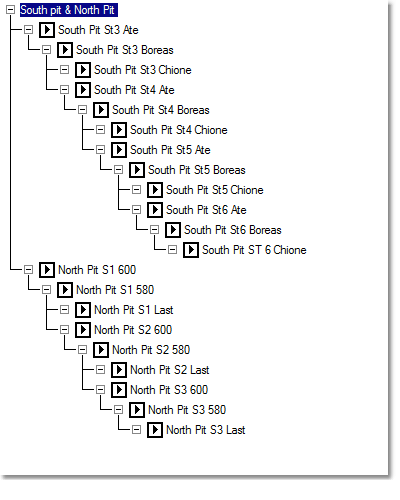|
<< Click to Display Table of Contents >> Supersequences Spanning Pits |
  
|
|
<< Click to Display Table of Contents >> Supersequences Spanning Pits |
  
|
Before reading this topic you should be familiar with the previous three topics. You should also be familiar with the sample pit described in these topics.
Creating a Supersequence to span several pits is a straightforward process and uses the same principles of Supersequence construction covered in the previous topics. The steps involved are:
1.For each Strip of each Pit to be included, create a Staged Excavation, Raw Sequence and create suitable Subsequences.
2.In the Supersequence Editor create Basic Supersequences for all of the branches required for the Supersequence. All Excavation Templates which have been created, for any Strip of any Pit will be available in the Supersequence Editor via the Excavation Template pulldown list. Once selected all of the Subsequences for a particular Template will be available for inclusion in the Supersequence. Using this procedure Basic Supersequences can be built for any Strip of any Pit for which Staged Excavation and Subsequences exist.
3.Create a new Supersequence for the multi–pit Supersequence. All of the Basic Supersequences created in step 2 will be available in the Supersequence Editor Supersequence List for inclusion in a Compound Supersequence. The Basic Supersequences are added using the process is described in previous topics. The result in Compound Supersequence will span Strips and Pits.
The procedure above uses Compound Supersequences. You can create Supersequences spanning Pits using Basic Supersequence, however given the likely complexity of these Supersequences the use of Compound Supersequences Is Highly Recommended.
The figure and video clip below show a Compound Supersequence spanning two Pits. One pit is the South Pit used in the examples in the previous topics. The second pit is the North Pit which is adjacent.
North Pit - South Pit Compound Supersequence:

Video clip showing excavation of two pit Supersequence: